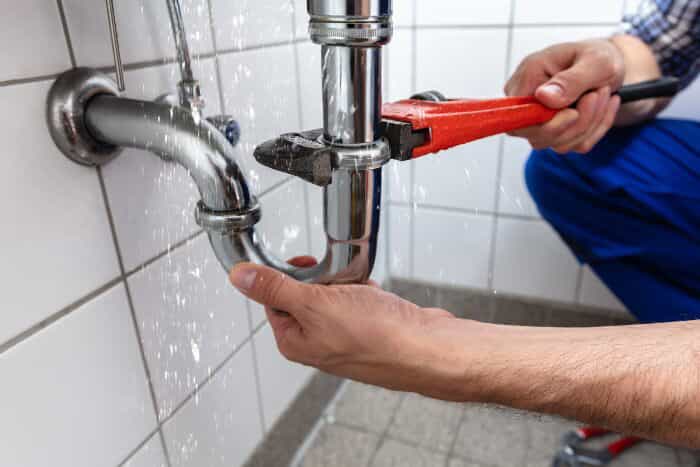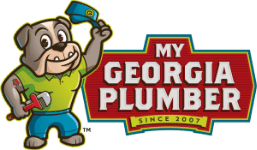
At My Georgia Plumber, we believe part of our job is to assist homeowners in the maintenance and upkeep of the plumbing systems in their homes. Homeowners who maintain their homes regularly not only increase the value of their homes but also reduce the repair costs over the lifetime of their homes.
Should you have any questions about your plumbing system or maintenance, our plumbers will gladly take the time to answer any questions you may have. There are also numerous articles throughout our site for those who are handy around the house.
Below are some common industry terms you may find helpful. Don’t see what you are looking for? Contact us with your question and one of our friendly staff will send you the answer within one business day.
What is a PRV?
What does an expansion tank do?
What is a ballcock?
We’re glad you asked!
– A –
Acrylonitrile Butadiene Styrene (or ABS) – a rigid black plastic pipe used for drain, waste, and vent lines.
Access Panel – an opening in the wall or ceiling near a fixture that allows for access to service the plumbing or electrical system
Angle Stop – a shutoff valve between a water supply pipe and the fixture it supplies. Used to shut off water to a fixture in the event of failure or repair.
Anode Rod – a rod inside of a water heater that protects the tank from corrosion; usually made of magnesium or aluminum; most manufacturer warranty lengths vary depending upon the quality of the anode rod of a water heater.
– B –
Backwater Valve – sewer line valve that prevents sewage from flowing back into the house.
Ball Check Valve – a type of backflow preventer that uses a ball to seal against a seat in a valve. It is installed on a water line so that water is allowed to flow in one direction only.
Ballcock – the fill valve that controls the flow of water from the supply line into a gravity-operated toilet tank. It’s controlled by a mechanism that floats in the tank water. When the toilet is flushed, the float drops and opens the ballcock. This releases water into the tank and/or bowl. As the water in the tank is restored, the float rises and shuts off the ballcock when the tank is full.
Branch – any part of a drain system other than the main, riser, or stack; also known as a lateral line.
Branch Vent – a vent connecting one or more individual vents with a vent stack.
BTU or British Thermal Unit – a unit of heat energy required to raise the temperature of 1 lb. of water 1 degree Fahrenheit.
– C –
Check Valve – a type of backflow preventer installed on a pipe so that water is allowed to only flow in one direction.
City Sewer – sewage disposal system operated by the city or county.
Cleanout Plug – a plug in a trap or drain pipe that provides access to the drain line for the purpose of clearing an obstruction.
Closet – toilet; also known as a water closet
Closet Auger – a flexible rod with a curved end used to access the toilet’s built-in trap and remove clogs.
Closet Bend – a curved fitting mounted immediately below the toilet that connects the closet flange to the toilet drain.

Closet Flange – anchoring ring that attaches to the closet bend and secures it to the floor. Closet bolts that secure the toilet in place are inserted into slots in the closet flange.
– D –
Diaphragm – flexible membrane in a valve body that regulates water flow from the supply lines and reduces build-up within a valve
Dip Tube – the tube inside a water heater that sends cold water down to the bottom of the tank

Drip Leg- a stub-ended pipe installed at the low point on a gas line; collects condensation and debris and allows for its removal; also known as a sediment trap
– E –
Escutcheon – a decorative metal flange or trim shield beneath a faucet handle that covers the faucet stem and the hole in the fixture or wall

Expansion Tank – a device designed to contain excess pressure due to thermal expansion
– F –
Fall – also known as flow; the proper slope or pitch of a pipe for adequate drainage
Fixture – in plumbing, the devices that provide a supply of water and/or its disposal (example: sinks, tubs, toilets, etc…)
Flapper Valve – the part on the bottom of the toilet tank that opens and allows water to flow from the tank into the bowl
Float Ball – the floating ball connected to the ballcock inside the tank that rises or falls with the changing water level in the tank
Floor Flange – a fitting that connects a toilet to the sewer line; also known as a closet flange
Flushometer – toilet valve that automatically shuts off after it meters a certain amount of water flow; Flushometers are usually found on commercial grade toilets

– G –
Gas Cock – gas valve installed on the main gas line and on a gas appliance to allow the gas to be shut off when necessary
Gas Control Valve – a device used to regulate gas pressure on a water heater.

Gate Valve – a device that controls the flow of liquid in a pipe.
Gravity Operated Toilet – a toilet that relies on the natural downward pressure of water in a toilet tank to flush the toilet effectively; most toilets in American homes are gravity operated

Gray Water – wastewater from sinks, showers, and bathtubs, but not toilets
– H –
Horizontal Branch – lateral drain pipes that run from plumbing fixtures to the waste stack in a building or in the soil
Horizontal Run – the horizontal distance between the point where fluid enters a pipe and the point at which it leaves
Hose Bib – an outdoor faucet or spigot typically used for watering plants, washing cars, etc…

– I –
Instantaneous Water Heater – a type of water heater that heats water as it flows through a heat exchanger coil; also known by the brand name “Insta-Hot”
– M –
Main Line – the primary line that supplies water from the water company’s meter at the street up to the point where it enters the home; all other supply lines in the home branch out from this mainline
– N –
Nipple – a short length of pipe installed between couplings or other fittings.
No-Hub Connector – a connector for no-hub iron pipe consisting of a rubber sleeve and a stainless steel band secured by hose clamps. Or a neoprene sleeve with two adjustable steel bands that are used for connecting dissimilar materials (for example, when connecting new plastic pipe to an existing cast-iron drainpipe.) Usually used in older homes.
– P –
Pitch – Downward slope of a drain pipe in the direction of the water flow, also known as the “fall” of the pipe.
Polybutylene – This is a soft, gray, or blue plastic pipe that was widely used from the mid- 70′s to the mid- 90′s across the nation. Since then it has become known that polybutylene deteriorates over time and leaks. Read more here.
Power Flush System – Toilet flushing system that compresses water to provide a pressurized flush as opposed to a gravity flush. Power-assisted toilets are more typically found in business or commercial settings.
PRV or Pressure Reducing Valve – a special valve installed on the main water line coming into the home so that water entering the valve from municipal mains is constricted within the valve body. It reduces water pressure coming into your home from the high level used by the water company down to a level that can be used in your home without damaging your fixtures.
PVC – Polyvinyl chloride. A rigid white or cream-colored plastic pipe used in non-pressurized systems, such as drainage, waste, and vent systems.
– R –
Rated Storage Volume – Quantity of water stored in a tank.
Rim Holes – a series of small holes in the underside of a toilet rim around the circumference of the bowl. Water flows down into the bowl through these holes and washes over the entire inner surface of the bowl.
Riser – a vertical metal or plastic supply line that connects a faucet or shower fixture to the water supply stop valve. It is usually made of copper though Metal Flex Risers are corrugated to facilitate bending. Also, the name of a supply line that rises from one story to the next.
– S –
Saddle Valve – a valve mounted on a pipe run by a clamping device, or fitting that taps into the side of a pipe, used to make a quick connection to an existing line to provide a water supply for a low-demand device.
Septic Tank – The holding tank for a small-scale sewage treatment system that serves a home that does not have a connection to the local city or county sewage pipes. The term “septic” refers to the anaerobic bacteria that live in the tank and decompose the waste discharged into the tank.
Sewage Ejector Pump – These pumps are required where wastewater cannot flow to its destination by means of gravity at a velocity of at least 2 feet per second. Nearly all residential plumbing systems rely on the force of gravity to move waste through the lines; but, occasionally, a fixture needs to be installed below the nearest available sewer or septic line (for example in a basement bathroom). The waste from the drain for this fixture must be lifted to the level of the main drain.

Shroud – Color-matched component under a wall-mount lavatory that covers the drain outlet for aesthetic purposes
Straight Stop Valve – A shut-off valve, like the angle stop but without the 90-degree turn.
Sump Pump – This type of pump is used where basement flooding happens regularly. A pit is dug in the basement. The water accumulates in the pit. Then, the sump pump pushes the water outside the home and away to an area where it is no longer problematic.
Supply Line – a metal or plastic line that carries water from the Main Line to an individual fixture (e.g. faucet, toilet, etc.) in the home.
– T –
T&P Valve or Temperature and Pressure Valve – temperature & pressure relief valve. A safety device used to expel excess pressure or heat from inside a tank. If the water in the tank gets too hot, some of it is released through the T&P valve.
Tailpiece – section of pipe that runs between a fixture outlet and the trap.
Thermocouple – small electric generator. Electron flow between the hot junction of 1200ºF and cold junction of 600ºF creates millivoltage.
Thermostatic Valve – Pressure-balancing shower mixing valve with automatic temperature control. When temperature or pressure fluctuations occur at the water inlets, a thermal actuator adjusts the hot and cold ratio to maintain the original temperature setting.
Trap – Curved section of drain line that prevents sewer odors from escaping into the atmosphere. All fixtures that have drains must have a “P” trap installed. A toilet is the only plumbing fixture with an “S” trap. The “S” trap is built into the base of the toilet.
Trap Seal – Height of water in a toilet bowl “at rest.” This water prevents sewer gases from entering the home.
Trapway – Channel in a toilet that connects the bowl to the waste outlet. This is where the siphonic action takes place. The trapway is measured in terms of the largest diameter ball which can pass through it. Also called the passageway. A toilet with a wide trapway can help reduce clogs.
Trip Lever – Flush handle and actuating arm on a toilet tank that is attached to the flapper to make the toilet flush. Also, the lever that opens and closes the drain on the bathtub waste and overflow.
– U –
Union – Three-piece fitting that joins two sections of pipe, but allows them to be disconnected without cutting the pipe. Used primarily with steel pipe; never in a DWV system
– V –
Vent – A pipe that allows air into a drain system to balance the air pressure, preventing water in the traps from being siphoned off.
Vent Stack – Upper portion of the vent line about the topmost fixture through which gases and odors escape.
– W –
Washing Machine Box – A fixture on the wall in the laundry area that holds the hot and cold supply lines for the washing machine. It also has a connection to the drain line so that water from the washing machine can be pumped out to the drain.
Water Hammer – A loud annoying noise or vibration made by your pipes when you turn the water on or off. It is caused by a pressure surge or wave when water in motion is forced to stop or change direction suddenly; for example, when a valve is suddenly closed. This pressure wave can cause major problems, from noise and vibration to pipe collapse. Water hammer can be stopped by adding
Winterization – The act of preparing a vacant home for winter by draining out the water heater and water lines and applying products to toilet bowls to prevent them from freezing.
Call in the Big Dogs at My Georgia Plumber for all your plumbing service needs. You can book an appointment if you live in Acworth, Alpharetta, Ball Ground, Canton, Cumming, Kennesaw, Johns Creek, Marietta, Roswell, Sandy Springs, Smyrna, Suwanee, Woodstock, or surrounding areas at 770-268-2331 or book online.







